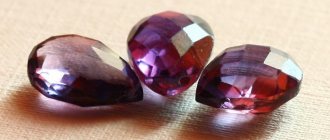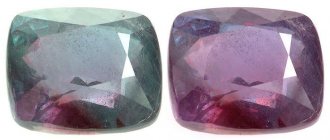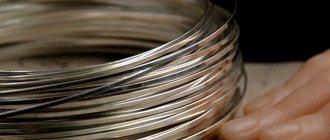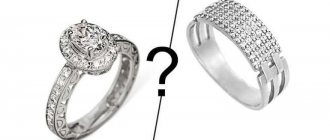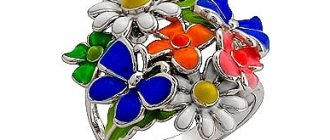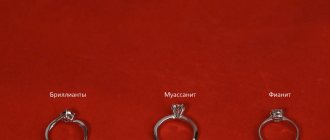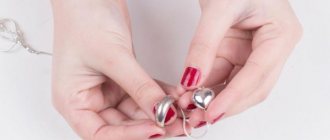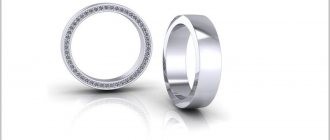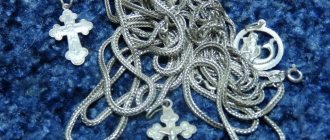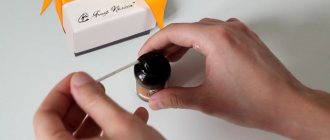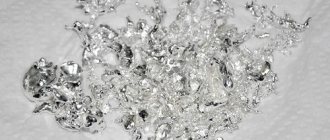Silver is a beautiful noble metal from which jewelry, coins, home decoration and dishes are made. And although silver items are counterfeited less often than gold items, sometimes it becomes necessary to verify the authenticity of the metal. How to test silver at home, read our article.
Pure silver has a silvery-white metallic hue and is highly reflective. However, if it is not cleaned for a long time, it darkens and becomes dull.
Sample and stamp
In order to check the authenticity of silver, first of all inspect the product for the presence of hallmarks and hallmarks.
The mark may look arbitrary, and sometimes be completely absent from the product. As for fineness, silver items sold on the international market must have a marked hallmark indicating the fineness of the metal. The most common numbers are 800, 830, 875, 925, 960; pure silver – 999 standard.
Do not be upset if you cannot find marks on the product - this does not mean that this is a different metal. Such a product may simply not be certified or produced in a country where the mark is not required.
The numbers on the marking indicate the percentage of silver in the alloy. For example, the 925 stamp indicates that the alloy contains 92.5% silver, and the 900 stamp indicates 90% silver content
There are other ways to test your silver. Let's take a closer look at them.
Rare coins of the Russian Empire made of low standard silver
The rarity of a coin is influenced by several factors. First, the total number of coins of a specific denomination with a specific date. Secondly, when mintzmeisters change, coins with the same date have different letters on the obverse. And one of the options can be minted in small quantities. Thirdly, the number of coins with “Proof” quality (mirror field and matte relief) is derogatingly small in comparison with similar examples of regular coinage. And in certain years, silver could be minted exclusively in “Proof”.
Among the rare five-kopeck coins, one can highlight 5 kopecks 1878 SPB-HI (Alexander II), 5 kopecks 1883 SPB-DS and 5 kopecks 1883 SPB-AG (Alexander III), 5 kopecks 1901 SPB-AR (Nicholas II). Only in “Proof” quality, 5 kopecks of 1904 SPB-AR and 5 kopecks of 1913 SPB-EB were minted in scanty quantities. The last time a silver five-kopeck piece was minted was with the date “1915.”
A rare ten-kopeck coin issued by Alexander II was 10 kopecks from 1878 SPB-NI . During the reign of Nicholas II, among the rarities were 10 kopecks from 1895 SPB-AG , as well as 10 kopecks from 1913 SPB-EB, known only as “Proof”.
Among the five-altyn coins of the era of Alexander III, 15 kopecks from 1882 SPB-DS . During the reign of Nicholas II, 15 kopecks of 1896 SPB-AG and 15 kopecks of 1899 SPB-EB . The year 1912 is significant in that 15 kopecks with the letters “VS” are rare in ordinary quality. But as a “Proof” rarity, a fifteen-kopeck coin from 1913 with the designation of the mintsmeister “EB” is listed.
A few words about 10 and 15 kopecks without letters on the obverse . Despite the impressive circulations, after the outbreak of the First World War, Russia began to experience a huge shortage of small change coins. Stamp money is even being introduced into use. Therefore, the order for the minting of an all-Russian coin with the date “1916” goes to the Osaka Mint (Japan). These coins are distinguished by the absence of the mintzmeister's initials. They are not rare. Their occurrence is approximately the same as that of their counterparts with the letters “VS” (the initials of Viktor Smirnov). I wonder if Japanese coins would still have the abbreviation “SPB” on the reverse? But since 1915, due to the renaming of St. Petersburg to Petrograd, these three letters disappear from the reverse of all Russian small change coins.
For two-kopeck coins, we highlight 20 kopecks of 1867 SPB-NF and 20 kopecks of 1878 SPB-HI (Alexander II), as well as again 1912, when 20 kopecks “VS” are rare in regular coinage, and 1913, where 20 kopecks “EB” known only in Proof. In this capacity, a similar story turned out with 20 kopecks of 1901 SPB-AR. 10, 15 and 20 kopecks manage to come out in small editions even in the year of the collapse of the empire. You can read more about the royal coins of 1917 here.
Magnet
Silver, like gold, is diamagnetic, so you can quickly check its authenticity using a magnet.
Bring a magnet to the item - if it is magnetic, it means that it is either a silver-plated item or made of another metal. If the item is not magnetic, there is a very high chance that it is real silver.
Testing with a magnet may not give the desired result if the main alloy material is copper. So, cupronickel and brass (copper alloys) will not be attracted to a magnet
Conclusions: can it be determined or not?
Despite all this, all these methods cannot be guaranteed to give an accurate result, since the coin can be made of half silver, that is, silver covers an ordinary coin, the share of the precious metal shell can reach only 15-20% of the total mass of the product. The only way to be one hundred percent sure is to make a thin notch on the side edge! But no matter how deceptive the appearance of a counterfeit coin may be, no matter how high the quality of the counterfeit, there is always a way to identify the counterfeit. In the case of rare specimens, it is better to entrust the task of verifying the authenticity of coins to professionals and numismatists.
Thermal conductivity
Silver has the highest thermal conductivity among metals - it heats up quickly and gives off heat just as quickly. Try temperature tests with the product.
If you have a coin or bar in your hands that needs to be checked for authenticity, use ice
Take an ice cube, place it on the product and observe carefully. If the ice melts quickly, as if it were placed on something very warm, you have silver in front of you. This test is suitable for flat items; it does not work well on small jewelry.
You can check a small piece of jewelry by simply picking it up - after a few seconds, the silver item will reach the temperature of your body. If you immerse a silver object in hot water for a moment, it will heat up to the temperature of the liquid in a matter of seconds.
Remember that silver darkens due to high temperature exposure, and in order to return it to its original appearance, you will have to clean the product
Voice test
This test is suitable for checking coins. When tapped, silver makes a ringing sound (especially if it is tapped with another metal). If you already have a proven silver coin, its ringing can be taken as a standard.
Gently tap the silver item (you can use another coin for this): if when you tap you hear a beautiful, open ringing, then this is real silver. If the sound is dull, it means there is little or no silver in the alloy.
A silver service can become a family heirloom and be inherited from generation to generation
lapis pencil
You can buy a lapis pencil at a pharmacy. It is often used for testing precious metals at home.
Wet the product and make a mark on it with a lapis pencil: if the metal changes color, then this is a sign of a fake. Since lapis consists of silver nitrate, it does not react in any way with either silver or gold.
Lapis pencil is a somewhat outdated remedy, and you can’t buy it at every pharmacy.
Sulfuric ointment
You can check the authenticity of silver at home using sulfur ointment (sold in pharmacies).
Apply the ointment to a small area of the product and wait 2 hours. Remove it from the surface with a dry cloth and carefully inspect the treated area: if the surface has darkened, this is silver; if it has acquired a different shade or remains unchanged, the product is made of a different metal.
The test with sulfur ointment is also carried out in another way: a small area of the product is rubbed with fine-grained sandpaper and lubricated with sulfur ointment. After 15 minutes, the result is assessed. If there is a dark spot left on the treated area, then there is a high probability that this is real silver. Metals such as nickel or stainless steel will not interact with sulfur ointment, and, accordingly, no stains will remain on the product.
To remove dark spots left after sulfur ointment, you can wipe the product with ammonia or put it in a soda solution.
Iodine and chalk
You can test silver with iodine.
In order not to spoil the product, carefully apply a small drop of iodine to the inner surface of the metal - a dark stain will remain on real silver. You can remove traces of iodine after testing in the following way: place the product in a bowl with grated potatoes or sprinkle with starch - under the influence of starch, traces of iodine will change their color and acquire an imperceptible bluish tint, merging with the color of silver.
Chalk not only checks, but also cleans silver. Crushed chalk is mixed with ammonia and the silver items are wiped with a soft cloth.
A similar test can be carried out using ordinary chalk. Rub the silver with a piece of chalk: a dark spot will form on the metal at the point of contact. If the blackness does not appear, you have a fake silver.
You can clean your jewelry using available products. Read how to do this in our article “How to clean silver at home.”
Introduction
Silver is a rather amazing precious and jewelry metal that is not only pleasant to look at, but also has healing powers. From ancient times, when human civilization was just beginning to the present day, silver has been actively used for making dishes, jewelry and various ritual utensils. Water storage tanks on spacecraft are also coated with silver. The magic of silver lies not only in its pleasant shine, softness and ductility, but also in its unique antiseptic properties. In this article, various methods of determining silver using improvised means and, in particular, determining the authenticity of silver coins will be discussed in detail. Quite often, coins indicate detailed information about what it is made of, and on some copies you can even find out how much of this very silver it contains, for example, as on the 50-kopeck USSR coin issued in 1924. But these days, many craftsmen have learned to make fairly high-quality fakes. So, in order not to fall for the trick of scammers, we will look at ways to determine whether a coin is made of silver or whether they are simply trying to deceive you. Or if you have already purchased a silver coin and are not sure of the seller’s honesty.
Vinegar
You can test silver with vinegar.
Pour the 9% table bite solution into a bowl and lower the product into the container for a few seconds. Since silver is a low-reactive metal, it will not react with vinegar. If a white coating appears on the product or other changes occur, this is a fake.
You can use a bite to clean silverware and dishes until they shine.
Nitric acid
You can test silver using nitric acid - this test is considered one of the most accurate.
Wear gloves and a protective mask, select an inconspicuous area on the product, lightly scratch it to remove any protective coating, and apply a drop of nitric acid. If you have a low-quality silver alloy - cupronickel or silver-plated brass - a greenish stain will remain on the product. This is due to the fact that the product contains high levels of copper. When exposed to nitric acid, silver will turn dark, while sterling silver (925) will turn creamy.
Today you can purchase a professional silver test in jewelry stores and conduct a chemical experiment at home.
How to distinguish silver from cupronickel
The peak of popularity of cupronickel was about 50 years ago. Then almost all tableware was made from this alloy of non-ferrous metals: nickel and copper with the addition of manganese and iron. This composition provided high wear resistance and strength, while not being inferior in ductility to silver.
It is almost impossible to determine by eye whether you are looking at cupronickel or silver. Use the sewing needle method to identify silver. If the needle leaves a dark mark, this means cupronickel.
You can also try nitric acid. Silver will darken, cupronickel will turn green.
Physical impact
You can check the authenticity of silver using physical impact.
Rub the product to be tested in your hands for 1-2 minutes. If you have high-quality silver in front of you, then your hands will remain clean after rubbing; if the product contains zinc impurities, barely noticeable dark spots will remain on your fingers.
Try testing your silver with a needle. If you suspect that you have a silver-plated product, lightly scratch an inconspicuous (internal) area with a needle: a thin layer of silver will easily be removed from a fake, but nothing will happen to the genuine metal.
The expert will give accurate information about the authenticity of silver and determine the content of impurities of other metals
All the methods described above will help determine the authenticity of a silver product with a certain degree of probability. To get a 100% guarantee, have your item examined by professionals: they know exactly how to test silver.
Gallery of the most popular copies
Making a stamp on an ancient coin that is similar in appearance to the original is not a cheap pleasure. Therefore, only mass production pays off. Let's look at the most common copies, while comparing them with the originals:
This is the original of the rare 1 ruble coin of 1912 “This Glorious Year”. The detailing of small elements is maintained. The font of the inscription on the reverse is clear. The font of the edge inscription corresponds to the given minting period.
This is a copy of this coin. The detailing of small elements is impaired (as can be seen when studying the copy under high magnification). The font of the inscription on the reverse is blurred (the clarity of the letters characteristic of coinage is absent). The font of the edge inscription has deviations, especially noticeable in the execution of the number “4”.
The original of the last commemorative ruble of the Russian Empire “Gangut” (left) and its primitive copy (right). Just look at the caricatured figure of St. George the Victorious on the coat of arms of Moscow. The maker of the copy was also lazy in depicting the four nautical charts, limiting himself to light strokes that vaguely resembled the lines on the original.
Beginners are often offered a copy of silver 2 rubles from 1722 under the guise of an original. This is an incredibly rare coin that has a proof status, but has come down to us only in the form of remakes. Its average market price is one and a half million rubles. But it’s enough to put the original (in the illustration it’s the coin on the right) and the copy (it’s on the left side in the photo) side by side, and the eye immediately catches many differences. The copy is missing a lot of small elements of the design (this can be seen at least by the crown on the reverse).
The rubles of Nicholas II are also being counterfeited en masse. The photo above shows the obverse of a 1903 silver ruble (left) and two copper-nickel copies. The fake in the center is annoying with a vague pattern. On the copy on the right, the font of the legend is quite elegant, but the imperial bas-relief was clearly not made by a master of sculpture.
Let's look at the reverses. The copy in the center again has obvious blurriness in the image. In addition, the engraver was too lazy to put a dot after the “G”. On the copy on the right, the execution of the State Emblem is done in a different manner than on the original. Just look at the tail.
And finally, one of the most expensive coins of the Russian Empire is the trial portrait ruble of 1796. If the original (in the photo - the coin on the left) shows us the pinnacle of medal art, emphasizing the grace of the imperial face, then the copy appears as a lopsided freak who has only an extremely distant resemblance to Paul I.
